The Evolution of Music Notation
Have you ever wondered why are there five lines on a stave, not four or six?
Who invented time signatures? Why isn’t there a B clef or an E clef?
Who made the rules for music notation?
Why do we use the letters A-G for musical notes, but the scale with no flats or sharps is C, rather than A?
Read on to find out everything you didn’t know you didn’t know about the history of music notation!
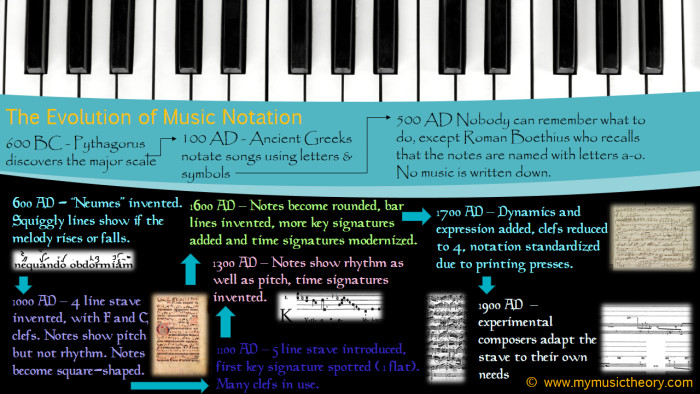
600 BC

Ancient Greece. Pythagoras, while walking past an blacksmith’s workshop, is intrigued that the sounds made by the smiths’ hammers sound like tuneful musical notes.
He goes home, crunches some numbers and works out the mathematical proportions governing the notes of the music scale. Pythagoras discovers that two notes which make an interval of an octave always have a ratio of 2:1. A perfect fifth is made with the ratio of 3:2, and a perfect 4th is 4:3. Combinations of these intervals then create the other notes which make up the major scale.
Music theory is born.
100 AD
Ancient Greece. Music was a big part of civic life, and the ancient Greeks had a way of writing it down. A carved tombstone dating back to 100 AD contains the earliest known example of a complete, notated song, with lyrics and music. It is known as the Seikilos Epitaph.
The Ancient Greeks labelled the notes of Pythagoras’ scale with letters from the Greek alphabet. The notes on this tombstone were written as letters, with special symbols written above them. The song’s lyrics were aligned below the notes.
The Seikilos Epitaph has been transcribed and recorded, and you can listen to an interpretation of it here.
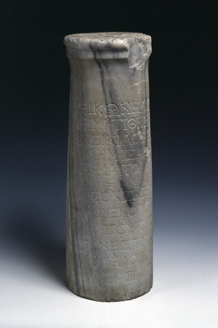
100-500 AD

Rome. Ancient Greece was a declining empire, but Rome was at its height of power and influence. Romans looked to the works of the Ancient Greeks for their knowledge of the Classical arts, mathematics and astronomy. Roman philosopher Boethius scoured the Ancient Greek texts for snippets about music notation, and wrote about their system using letters for naming the notes of the scale.
Writing in Latin, Boethius tells us that the letters from a to o (Roman letters) are used. “A” is the lowest note that a male voice can sing, and o is the highest. Boethius’ text book was used for hundreds of years across Europe in universities. Despite the Romans’ ability to name musical notes, no notated Roman music has yet been discovered. Music of this time was passed down by memory alone.
600 AD
Europe. The hotbed for musical activity is the Church. Monks sing religious songs known as “Plainchant”, and a monk’s training includes years’ of memorising plainsongs by heart.
The portfolio of songs is becoming unmanageable and a way of sorting and categorising the songs is needed. A system called neumes is developed to solve this problem.
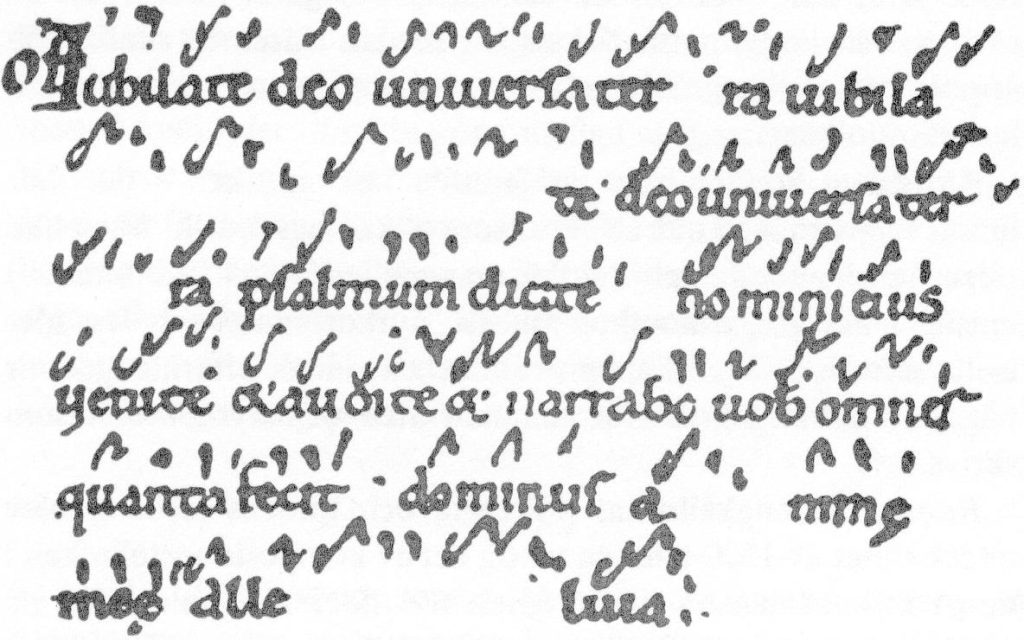
Strange looking flecks and squiggles are written above the words to each song. These symbols tell the singers when the pitch is rising or falling. They don’t give any indication of how high or how low each note is in relation to its neighbours, and there is no attempt to notate the rhythm. But it’s a start. The system catches on like wildfire, with each monastery across Europe making its own in-house “improvements” – different shaped symbols are used for small groups of notes.
1000 AD

Italy. Benedictine monk Guido d’Arezzo (c.992-1033) is a music teacher extraordinaire. It is Guido who has the bright idea of drawing a line on the page, so that neumes can be placed with a fixed pitch.
He begins by using a single red line, which he labels with one note – either F or C. This is the starting point. Neumes are then written on the line, above it or below it, showing relative pitch. The note letter placed at the beginning of the line will become known as the clef.

Guido develops his system over the years, adding extra lines and different colours. His system is widely adopted, and it is the four-line stave which gains most favour.
At the same time, the squiggly neumes are gradually replaced with square-shaped note symbols.
1100-1200 AD
Europe. By the 13th century we find plenty of manuscripts using a 5-line stave (as well as other stave sizes). We also find the first key signatures which at this stage consist of just one flat. There were no sharp key signatures at this time.
This manuscript is quite famous and shows the song “Sumer is icumen in“. The letter “C” (in black) is a clef, showing the location of the note C, and just next to it is a flat symbol for Bb.
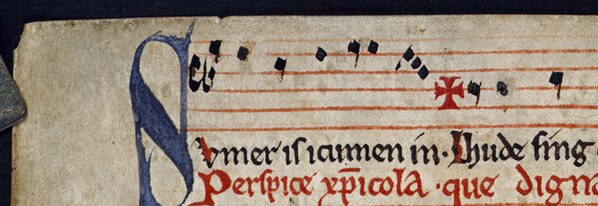
1300 AD

Europe. Mensural notation is born – in other words, they figure out how to make a musical note represent both pitch and rhythm. Plainchants have become so complicated rhythmically, that a method is needed to notate the rhythm, rather than leave it up to the memory alone.
A complex system is derived, which allows for four basic “time signatures” (called “mensurations”). Theorists decide that there are two types of rhythm – duple and triple. Each of those can be further subdivided into a duple or triple rhythm, making four possibilities. (Quadruple rhythm doesn’t feature.)
Four symbols are invented to represent these mensurations. A vertical line cut through the symbol meant that the basic beat was halved.

The symbols we sometimes use for “common time” (4/4) and “cut common time” (2/2) date back to this time!
The note names we use in Europe today are also invented during this time. The longest duration of note is the “maxima”, followed by the “longa”, then the “breve” (meaning “brief”). Half a breve is a “semibreve”, and half a semibreve is the smallest length of note – the “minima”. Bar lines are still not used, however. The “maxima” was probably about as long as a modern semibreve – musical notes have a tendency to gradually speed up over the centuries!
1600 AD
Europe. Bar lines arrive! The 17th century sees a huge number of developments in music notation. Now that composers can write down their musical ideas, their creative juices get flowing like never seen before. Imagine if Bach had not been able to notate his compositions!
By this time, notes have taken on their familiar oval shape, and the smaller notes (crotchet [quarter note] and quaver [eighth note]) have been introduced.
With compositions becoming more complex in terms of key and rhythm, an overhaul of the time signature system is needed. The old system of four possible time signatures is abandoned, and the modern “fraction-style” time signatures we use today is invented. Key signatures with sharps are also introduced.
Innovations are happening everywhere, and there is no consensus about the right way to do things at first. Key signature sharps and flats can be written in any order, and minor keys using flats often used one flat less than we would today. For example, a G minor piece might be written with one flat (since the 6th degree of the scale is often unflattened anyway).

1700 AD
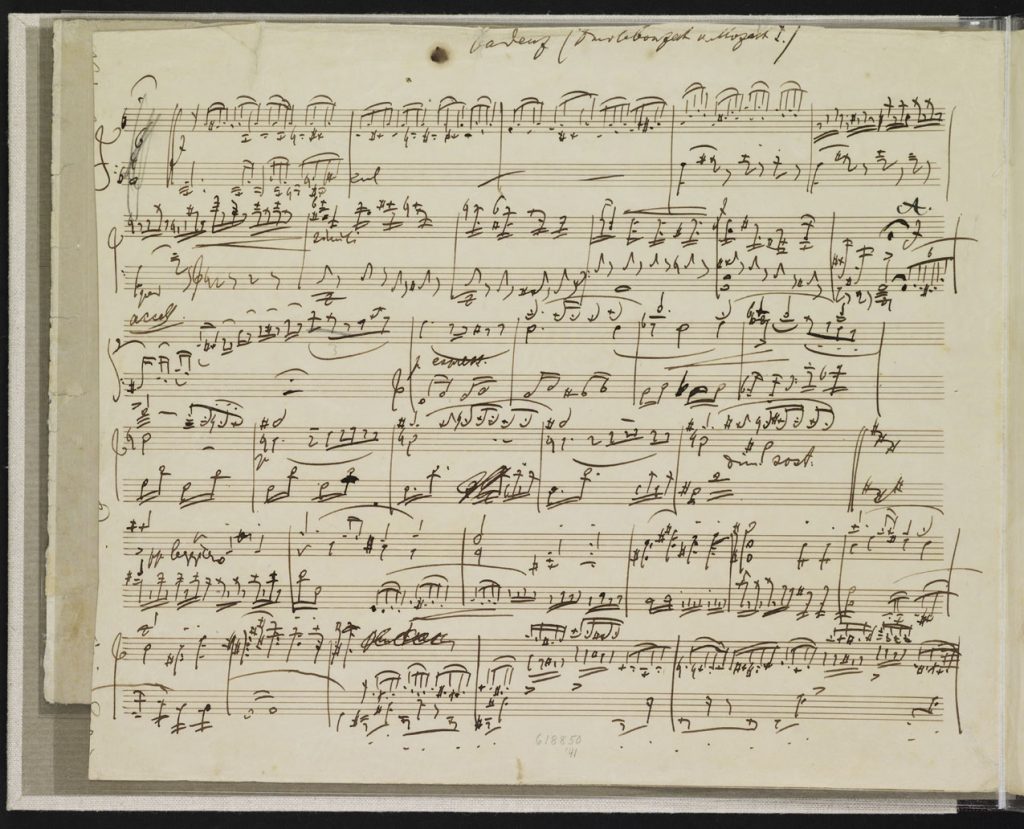
Europe. Baroque music is evolving into Classical music, and musical notation has to keep up with the trend. Classical music uses dynamics much more expressively than Baroque, with sharp contrasts of loud and soft passages. Contrasts of attack also feature heavily, with smooth legato passages alternating with harsh staccato or accents. Music notation begins to incorporate symbols such as staccato and slurs, and letters for dynamics (p and f).
Music notation at this point in history looks very much like what we are used to today. The number of clefs is gradually reduced to the three/four that we continue to use in modern scores – the G clef (treble), the F clef (bass) and the C clefs (alto and tenor).
Also at this time the printing press allows music to be published to the masses. Printing leads to a standardisation of many aspects of notation.
1900 AD
As in all previous centuries, music notation has continued to evolve as music itself has evolved. New ideas in the 20th century include microtones (notes closer together than semitones), prepared instruments (e.g. a piano with a hammer stuck in between the strings), aleatoric music (i.e. based on chance – the music is different each time it’s played) and other special effects. Composers generally adapt the traditional notation to suit their purposes, although the 20th century has also seen some musicians completely rejecting traditional notation and starting again from scratch.
With the advent of music technology, we wonder what innovations the 21st century will bring, and whether traditional notation will eventually be abandoned altogether. What do you think?
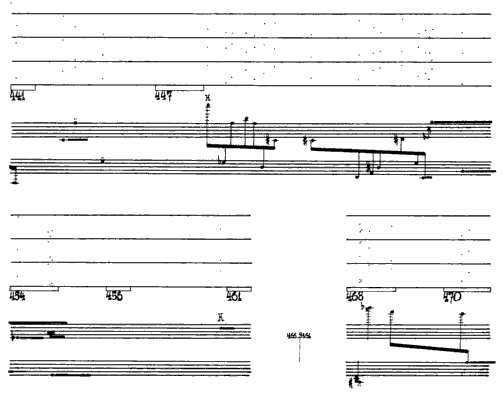
All dates are approximate!)
Images: Wiki Commons Images